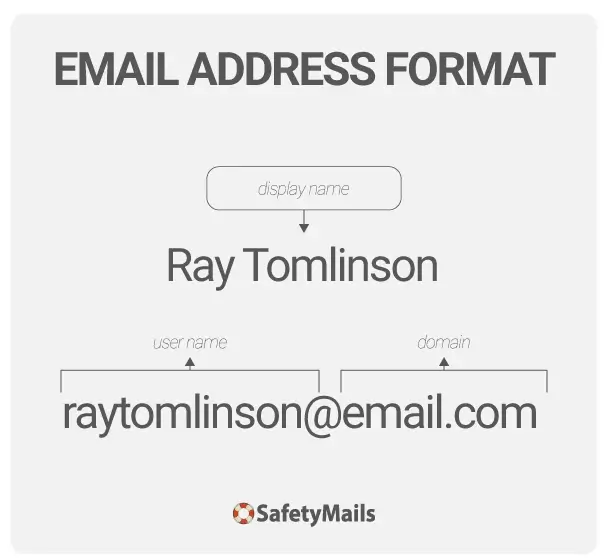In this article, we’re going to give you an email format example. More than that, we’ll cover the importance of each element of a well-written email, including the email address itself.
Professionalism in the corporate environment is fundamental, both for those who are looking for new opportunities and for those who want to progress in their careers or get new clients.
Clear and effective communication is essential. A professional email address conveys a perception of professionalism that brings authority. And a well-formatted email ensures that your message is understood and well received by the recipient.
Table of Contents
Email format example in email addresses
It may not seem like it, but a professional email address is your business card when sending a message.
Apparently, people don’t like to receive messages from their business partners, doctors or lawyers via an @gmail.com email address, for example. This conveys an idea of improvisation and lack of professionalism, as we usually associate this and other free service domains with personal email accounts.
So make sure you use a professional email address, with its own domain, and carefully check the recipient’s name and address before sending. Getting a domain and an email hosting service is very simple and affordable in terms of budget.
Don’t forget to choose suitable, memorable and intelligent local-part names.
Avoid common addresses that could be spammed by dictionary attacks:
- contact@
- sales@
- notes@
Give preference to more interesting variations, such as:
- team.sales@
- fabio.ramos.psychology@ (name + profession or function)
- happy.customer@ (creative ways of calling customer support)
Use of exclusive email domains
Some companies opt for a sectorization strategy when creating their domains on the Internet.
In order to avoid spammers using dictionary attack techniques, companies can use variations of their domains for different purposes.
For example:
- Official website domain: @domain.com
- Email domain: @domainmail.com
- Domain for automated messages: @domainsystem.com
- Domain for subsidiary websites: @domain-state.com
Email format in detail
A valid email address is made up of 3 parts: a prefix (local-part), an @ symbol and a domain.

The prefix is the part of the email that comes before the @ symbol and identifies the user behind that email account or the function for which it is intended.
The @ symbol is the part of the email that separates the prefix from the domain. Therefore, it cannot be used in any other part of the email, otherwise it will be invalid due to a syntax error.
Finally, the domain, which is the complement of where the message will be delivered.
If you want to know more about the syntax of email addresses, SafetyMails has dedicated a post to explaining each part of the syntax of an email address in detail.
Elements of a well-written email
For an email to be written, it’s not enough to focus on just one aspect, such as good vocabulary. You need to pay attention to several aspects. Let’s talk about each of them.
Fluency
Mastering good copywriting techniques and trying to write messages in the best possible way allows the message to be clear and understandable.
When an email is well-structured and flows naturally, with well-connected ideas consisting of an introduction, development and conclusion, the recipient can quickly understand the content and purpose of the message, facilitating effective communication.
In addition, fluent and well-written emails reflect professionalism and attention to detail, strengthening the sender’s image and increasing the likelihood of getting more positive responses.
Subject line
The subject line is one of the most discussed and studied topics when we talk about the efficiency of email communications, especially email marketing. This is because 7 out of 10 messages are read because of the subject line.
However, the subject line in direct email messages between professionals is just as decisive as those sent in email marketing messages. This is because the subject line plays a fundamental role in the recipient’s decision to read.
First of all, we must remember that email inboxes are basically large repositories of lines of text on every possible topic, competing for the recipient’s attention.
These emails are usually not all read, let alone read in the order in which they arrive. But they do go through a mental process of prioritization on the part of the recipient. What will be read first? Which are the most important issues to deal with? And what will be ignored?
That’s why the subject line must be clear and specific.
In addition, the subject line should include elements that are key to activating emotional triggers related to the importance of a given topic, such as the completion of a process, confirmation of an activity, a follow-up related to a meeting, etc.
Greetings
The initial greeting already sets the tone of the email, whether it’s more formal or informal. This will depend, for example, on the market in which you operate. So choose a greeting that matches the level of formality of the relationship with the recipient.
- Formal: “Dear Mr. Doe,”
- Informal: “Hello John,” or “Hi John,”
Email body
After the first formalities of greeting, it’s time to get straight to the point and set out your intentions in the body of the email message.
So that your ideas are divided up and presented in the best way, distribute your text following this logical structure:
- Opening paragraph: Presents the purpose of the email.
- Development: Details the information or request.
- Closing paragraph: Concludes the email with a summary or call to action.
In the opening paragraph, you give a brief introduction and a short summary of your intentions in that email. Consider this part as a kind of summary of what will be said next, almost like an index.
During the development, give details about the information or request you have to make, offering details and suggestions.
In the closing paragraph, it’s interesting to use call-to-action techniques that make the recipient feel impelled to respond to the message.
So, an email format example could be:
| Subject line | Q4 Budget Review Meeting |
| Greetings | Dear Mr. Doe, |
| Opening | I would like to schedule a meeting to review the budget for the fourth quarter of 2024. |
| Development | As an agenda for this meeting, we can discuss the planned expenses, necessary adjustments and strategies to optimize resources. I suggest we meet next Wednesday, July 12th, at 10am. |
| Closing paragraph | Do you agree with this schedule? If this time is not convenient, please let me know of an alternative that works better for you. |
| Closing | I look forward to hearing from you and thank you for your attention. I’m happy to help. |
| Signature | Jane Doe Chief Financial Officer ABC Corp. Email: [email protected] |
Closing
Since we mentioned the closing and signature items in the previous example, let’s talk about them briefly.
An appropriate closing reinforces the message and leaves a positive impression. It’s always important to emphasize your availability and thank the recipient for their attention.
Example: “Thank you in advance for your attention and I remain at your disposal for any further clarification.”
Your final greeting will also depend on the more or less formal tone of the email you are writing:
- Formal: “Sincerely” or “Cordially”
- Informative: “See you soon”, “Let’s talk” or even “Cheers”.
Signature
Finally we come to the email signature. Here, it should contain essential information about you (name, position or role) and how to get in touch, with email, telephone and social networks (such as LinkedIn).
Some signatures also include the sender’s photo, as well as some hyperlinks to a website or link aggregator, important seals related to awards, quality, good reputation, among others.
Email format example in email messages
If you want an email format example, we’ve prepared two of them to inspire you:
Feedback from a meeting
Subject: Summary of today’s meeting
Hello Mr. Doe,
I would like to thank you for today’s meeting. It was very productive and enlightening. Here are the agreed points:
- Test Account: The test account will be released as agreed.
- Training: The support team will train the client.
- Commercial Proposal: A commercial proposal will be sent by the account manager.
- Next meeting: Our next meeting is scheduled for two weeks from now.
Thank you again for your cooperation and I’m happy to answer any questions you may have.
Sincerely,
Welcome email to new customers
Subject: ABC Corp welcomes you and you take your first steps
Hello [Customer Name],
Welcome to ABC Corp! We are very happy to have you with us. To help you get started, we’ve put together some useful links:
- Client Dashboard: [Link to client dashboard]
- Service Agreement: [Link to agreement]
- Privacy Policy: [Link to privacy policy]
For any questions or support, you can contact your account manager, [Manager’s Name], via email at [manager’s email] or by phone at [manager’s phone number].
Thank you for your trust and we are at your disposal for whatever you need.
Sincerely,
Summary of tips for writing an effective email
Here’s a short summary that you can use as a checklist for the emails you’re drafting:
- Use a professional email address: Avoid informal or personal addresses.
- Proofread: check spelling, grammar and the recipient’s name before sending.
- Objectivity: be clear and direct, avoiding unnecessary information.
- Attachments: make sure that all attachments mentioned are included.
Conclusion
In summary, writing a professional email involves several elements that must be carefully considered to ensure clear and effective communication.
The use of a professional email address, a clear and specific subject line, an appropriate salutation, and a logical and flowing structure in the body of the email are fundamental.
In addition, a proper closing and a complete signature reinforce the message and leave a positive impression on the recipient.
Following these guidelines not only makes the message easier to understand, but also strengthens the sender’s image, promoting more efficient and professional communication.
To stay well-informed, follow the SafetyMails articles.
SafetyMails is an Email Validation and Verification Tool. With it you can remove invalid, non-existent, spam traps, temporary and junk emails from your mailing lists, and protect forms in real time with its API. Create a free account now.
FAQ
A professional email address conveys seriousness and credibility. Using your own domain instead of a free service, such as @gmail.com, can improve the perception of professionalism and avoid associations with personal accounts.
The subject line is crucial because it determines whether the recipient will open the email. It should be clear and specific, reflecting the content of the email and, where possible, including elements that activate emotional triggers to increase the relevance and urgency of the message.
The initial greeting sets the tone for the email. Choosing a greeting appropriate to the level of formality of the relationship with the recipient can positively influence the reception of the message, showing respect and consideration.
An effective email is well-structured, with a clear introduction, development and conclusion. Well-connected ideas and fluent writing help the recipient to quickly understand the message, facilitating effective and objective communication.
The closing reinforces the message and leaves a positive impression, while the signature provides essential contact information. An appropriate closing and a complete signature demonstrate professionalism and availability, encouraging the recipient to respond or take a specific action.


